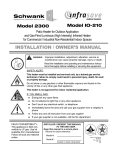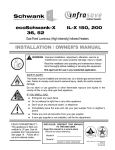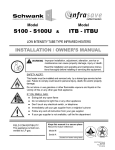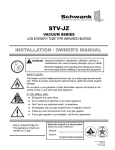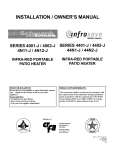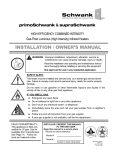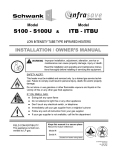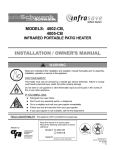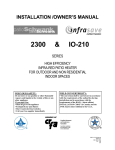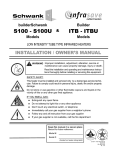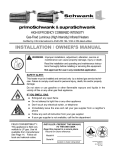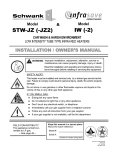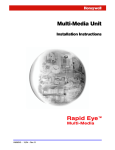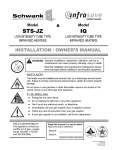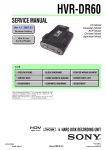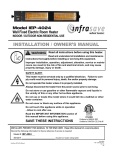Download Schwank IO-100 Owner`s manual
Transcript
bistroSchwank Series Models: 2100; 2100-SS* 2152; 2152-SS* Series Models: IO-100; IO-100-SS* IO-152; IO-152-SS* * Marine Grade Stainless Steel Cabinet Patio Heater for Outdoor Application and Gas-Fired High Intensity Infrared Heater for Commercial / Industrial Non-Residential Indoor Spaces INSTALLATION / OWNER’S MANUAL WARNING Improper installation, adjustment, alteration, service or maintenance can cause property damage, injury or death. Read the installation and operating and maintenance instructions thoroughly before installing or servicing this equipment. SAFETY ALERT: This heater must be installed and serviced only by a trained gas service technician. Failure to comply could result in personal injury, death, fire and/ or property damage. Do not store or use gasoline or other flammable vapors and liquids in the vicinity of this or any other gas fired appliance. This heater is not approved for indoor residential application. IF YOU SMELL GAS: Extinguish any open flame Do not attempt to light this or any other appliance Don’t touch any electrical switch, or telephone Immediately leave the area and call your gas supplier from a neighbor’s phone Follow any and all instruction from your gas supplier If your gas supplier is not available, call the fire department FIELD CONVERTIBILITY: This appliance is field convertible to LP gas (except 2152/IO-152: NG only). Only use kit available from manufacturer. Follow kit instructions and all local and national codes. INSTALLER: PRESENT THIS MANUAL TO THE END USER. Keep this manual in a secure place. Record for future reference: Model #: Serial #: (located on heater rating label) 2100 / IO 100 Manual IM110107 RD: MAY 2014 R.L. 4A NOTICE: The manufacturer reserves the right to make changes to equipment and specifications without obligation or notification. This publication, or parts thereof, may not be reproduced in any form, without prior written consent from the manufacturer Unauthorized use or distribution of this publication is strictly prohibited. Schwank Group PO Box 988, 2 Schwank Way Waynesboro, Georgia, USA 30830 5285 Bradco Boulevard Mississauga, Ontario L4W 2A6 Technical Support & Customer Service: Phone: 1-877-446-3727 Fax: 1-866-361-0523 e-mail: [email protected] Complete product information: www.SchwankUSA.com www.Schwank.ca www.InfraSave.com 2 2100 / IO 100 Manual IM110107 RD: MAY 2014 R.L. 4A Models: 2100; 2100-SS; 2152; 2152-SS IO-100; IO-100-SS; IO-152; IO-152-SS Patio Heater for Outdoor Application and Gas-Fired Luminous (High Intensity) Infrared Heater for Commercial / Industrial Non-Residential Indoor Spaces TABLE OF CONTENTS TOPIC TOPIC PAGE NUMBER 8. ELECTRICAL - BASIC REQUIREMENTS ……..19 9. LAYOUT, COMFORT & CONTROL................. 20 10. INSTALLATION PROCEDURES ..................... 21 11. LIGHTING INSTRUCTIONS ............................ 22 11.1 SHUT DOWN INSTRUCTIONS.............. 22 12. HEATER FINISH & APPEARANCE................. 22 13. SERVICING GUIDE......................................... 23 14. VENTILATION FOR INDOOR APP’S .............. 24 15. REMOTE CONTROL OPTIONS...................... 25 Remote Control Quick Setup ................26 - 30 16. SEQUENCE OF OPERATION-FENWAL 35-60 DSI................................................................... 31 17. SPARK IGNITION CIRCUIT ........................... 32 18-A WIRING DIAGRAM - SINGLE-STAGE ......... 33 18-B WIRING DIAGRAM - TWO-STAGE.............. 34 18-C WIRING - 2-STAGE SWITCH CONTROL .... 35 19. TROUBLESHOOTING GUIDE ........................ 36 20. COMMISSIONING REPORT ........................... 38 21. HIGH ALTITUDE DERATION ......................... 40 22. ACCESSORIES: Control & Mounting .............. 41 23. REPLACEMENT PARTS LIST........................ .43 Stainless Steel Enclosure Components ........... 44 LIMITED WARRANTY ........................Back Page PAGE NUMBER IMPORTANT INFORMATION - READ FIRST IMPORTANT WARNINGS ............................4 HEATER EXPANSION .................................5 GAS CONNECTION .....................................5 VENTING ................................................5, 13 ‘SMOKE’ & DISCOLORATION ....................5 MOUNTING CLEARANCES: OUTDOORS ...........................................6 INDOORS ...............................................9 DIMENSIONS & CONFIGURATION ..........11 MOUNTING KIT OPTIONS................. 12 - 15 1. APPLICATION .................................................. 16 OUTDOOR / PATIO ..................................... 16 INDOOR INSTALLATION............................. 16 2. AIRCRAFT HANGARS ..................................... 17 3. GARAGES & PARKING STRUCTURES .......... 17 4. OTHER THAN SPACE HEATING..................... 17 5. PRE-INSTALLATION SURVEY ........................ 17 6. INSTALLATION REQUIREMENTS................... 18 6.1 MOUNTING CLEARANCES ...................... 18 6.2 HEATER MOUNTING ................................ 18 7. GAS SUPPLY PIPING ...................................... 19 7.1 GAS PRESSURE....................................... 19 IMPORTANT Installer: Present this manual to the end user. Acquaint the end user with Important Information: Cover & pages 4 to 7. END USER: In particular you must be aware of ‘Clearances to Combustible’ requirements and the limitations of stacking or placing material near the heaters. Inform your safety personnel and staff of this information. 3 2100 / IO 100 Manual IM110107 RD: MAY 2014 R.L. 4A WARNING Improper installation, adjustment, alteration, service or maintenance can cause property damage, injury or death. Read and understand this installation and operation manual thoroughly prior to assembly, installation, operation or service to this appliance. This heater must be installed and serviced only by a trained gas service technician. Do not store or use gasoline or other flammable vapours and liquids in the vicinity of this or any other gas fired appliance. Failure to comply to these warnings could result in personal injury, death, fire and/ or property damage. This appliance may have sharp edges and corners. Wear protective clothing such as gloves and protective eye wear when servicing this or any other appliance. WARNING DO NOT INSTALL THIS APPLIANCE IN A RECESS, ALCOVE, OR ENCLOSURE. While minimum clearances to combustibles are stipulated to ensure safe installation, adequate free space must be provided to allow the products of combustion to escape from the heater to atmosphere when installed outdoors, or to mechanical exhaust withdrawal when installed indoors. Also refer to “Outdoor” and “Indoor” definitions and requirements on page 9. Do not allow the products of combustion to accumulate in any space or enclosure. WARNING Due to the effects of radiant heat upon certain materials it is not recommended to store or place items that could be damaged or distorted, directly under this heater....i.e. combustible patio furniture etc. Clothing or other flammable materials should not be hung from, or placed near to the heater Children and Adults should be alerted to the hazards of high surface temperatures and should be careful to avoid burns or clothing ignition Young children should be carefully supervised when in the area of a heater WARNING This heater is not for installation in a Class 1 or Class 2 explosive environment, nor for any residential application. If installation of this equipment is in question, consult with local authorities having jurisdiction (Fire Marshal, labor department, insurance underwriter, or others). Revisions to codes and/or standards, may require revision to equipment and installation procedures. In case of discrepancy, the latest codes, standards, and installation manual will take priority over prior releases. IMPORTANT: DO NOT INSTALL THIS HEATER INDOORS IN A STRUCTURE WITH NO INSULATION IN THE ROOF—CONDENSATION WILL OCCUR. 4 2100 / IO 100 Manual IM110107 RD: MAY 2014 R.L. 4A WARNING Heater Expansion It is a normal condition that during heat-up and cool-down a radiant heater will expand and contract. Allowances for heater expansion must be made in the gas connection and heater suspension. Improper installation, alteration, or adjustment can result in property damage, injury or death. WARNING Gas Connection Improper installation, connection, or adjustment can result in property damage, toxic gases, asphyxiation, injury or death. Use an approved stainless steel flexible gas connector (field supplied) to connect to the gas supply to the heater in accordance with all local, state, provincial, and national codes (ANSI Z223.1/NFPA 54 in USA; B149.1 in Canada) and as indicated in this manual. WARNING Venting Inadequate venting of a heater may result in asphyxiation, carbon monoxide poisoning, injury or death. When used indoors, this heater is indirectly vented from the space. Venting must be in accordance with all local, state, provincial, and national codes (ANSI Z223.1/NFPA 54 in USA; B149.1 in Canada) and as indicated in this manual. Refer to Section 13 WARNING Start-up ‘Smoke’ & Discoloration Condition During start-up, the heating of material coatings used in the production process of the heater may create a small amount of smoke during the initial period of operation. This condition is normal and temporary . Ensure that there is sufficient ventilation to adequately clear any ‘smoke’ from the space. Notify site management and safety personnel to ensure that alarm systems are not unduly activated. WARNING Heater Discoloration / Staining Stainless Steel & Painted Finishes: Surface discoloration or staining will occur on any heater body due to heat. Discoloration due to heat is a normal occurrence especially with all stainless steel. Surface discoloration does not affect the operation or performance of the heater nor the manufacturer’s component warranties. (Refer to Section 12: Heater Finish & Appearance, page 20) Some discoloration may be the result of the deposit of ambient air-borne particulate or gases within the space that have passed through combustion to create ‘smoke’. The combustion of fuel gas in a clean environment will not cause smoke discoloration deposits. 5 2100 / IO 100 Manual IM110107 RD: MAY 2014 R.L. 4A WHEN INSTALLED AS AN OUTDOOR PATIO HEATER see pages 9 - 10 for Indoor installation Also refer to “Outdoor” and “Indoor” definitions and requirements on page 11 WARNING Certain materials or items, when stored under the heater, will be subjected to radiant heat and could be seriously damaged. Location of flammable or explosive objects, liquids or vapors close to the heater may cause fire or explosion and result in property damage, injury or death. Do not use, store or locate flammable or explosive objects, liquids or vapors in proximity of the heater. The clearance to combustible material represents the minimum distance that must be maintained between the outer heater surface and a nearby surface. The stated clearance to combustibles represents a surface temperature of 117F° (65C°) above ambient temperature when installed outdoors. It is the installer’s responsibility to ensure that building materials with a low heat tolerance which may degrade at lower temperatures are protected to prevent degradation. Examples of low heat tolerance materials include vinyl siding, fabrics, some plastics, filmy materials, etc. It is beyond the scope of these instructions to consider all conditions that may be encountered. Consult local authorities such as the Fire Marshall, insurance carrier, or safety authorities if you are uncertain as to the safety or applicability of the proposed installation. Refer to Table 1 & Figure 1 Next Page for the minimum mounting and clearances to combustibles for Outdoor Patio application. WARNING DO NOT INSTALL THIS APPLIANCE IN A RECESS, ALCOVE, OR ENCLOSURE. Adequate free space must be provided to allow the products of combustion to escape from the heater to atmosphere when installed outdoors, or to mechanical exhaust withdrawal when installed indoors. Do not allow the products of combustion to accumulate in any space or enclosure. Note: Do not store or place anything directly under heater Ensure mounting height in any location is sufficient to prevent patrons from coming in contact with heater, and clearance to combustibles is maintained. 6 2100 / IO 100 Manual IM110107 RD: MAY 2014 R.L. 4A Table 1: OUTDOOR - MINIMUM MOUNTING & CLEARANCES TO COMBUSTIBLES Ends MODEL NO HORIZONTAL UP TO MAXIMUM 30° ANGLE E A S MH CH T B F MA CA 2135 / IO-135 -N\L 14” 13” 14” 108” 133” 17” 9” 60” 102” 127” 2150/ IO-150 -N\L 14” 16” 19” 120” 148” 20” 8” 62” 114” 142” 2152/ IO-152 -N\L 14” 16” 19” 120” 148” 20” 8” 62” 114” 142” Figure 1: OUTDOOR - MOUNTING CLEARANCES NOTE: MOUNT HEATER AT MAXIMUM 30° ANGLE TO AVOID DAMAGE See Table 2 Next Page for “Suggested Mounting Height for Comfort” The clearance to combustible material represents the minimum distance that must be maintained between the outer heater surface and a nearby surface. In an OUTDOOR application the stated clearance to combustibles represents a surface temperature of 117F° (65C°) above ambient temperature. It is the installer’s responsibility to ensure that building materials with a low heat tolerance which may degrade at lower temperatures are protected to prevent degradation. Examples of low heat tolerance materials include awnings, vinyl siding, fabrics, some plastics, filmy materials, etc. 7 2100 / IO 100 Manual IM110107 RD: MAY 2014 R.L. 4A Table 2: SUGGESTED MOUNTING DISTANCES FOR COMFORT MODEL 2150 / 2152 (-SS) IO-150 / IO-152 (-SS) 50,000 Btuh MOUNTING PARAMETERS *** MODEL 2135 (-SS) / IO-135 (-SS) 35,000 Btuh A - Mounting angle Horizontal 300 Horizontal 300 H - Suggested height above deck 9’ 6” 9’ 0” 10’ 6” 10’ 0” S - Side distance to patio edge 4’ 0” 4’ 0” 5’ 0” 5’ 0” Y - Side distance between heaters 8’ 0” 8’ 0” 10’ 0” 10’ 0” W - Distance effective coverage 7’ 0” 8’ 0” 8’ 0” 10’ 0” Z - Front distance between heaters 14’ 0” 16’ 0” 15’ 0” 18’ 0” Figure 2: MOUNTING PARAMETER DISTANCES S Y *** Note: Mounting angles and distances are suggested to ensure comfort, and are subject to site and design conditions. If in doubt, please contact your Schwank / InfraSave distributor. Ensure mounting height in any location is sufficient to prevent patio patrons from coming in contact with the heater Z A W H 8 2100 / IO 100 Manual IM110107 RD: MAY 2014 R.L. 4A WHEN INSTALLED INDOORS FOR COMFORT OR SPACE HEAT see pages 6- 8 for Outdoor installation Also refer to “Outdoor” and “Indoor” definitions and requirements on page 11 And refer to Indoor Ventilation Requirements page 19 WARNING Clearance to Combustibles Location of flammable or explosive objects, liquids or vapors close to the heater may cause fire or explosion and result in property damage, injury or death. Do not use, store or locate flammable or explosive objects, liquids or vapors in proximity of the heater. The clearance to combustible material represents the minimum distance that must be maintained between the outer heater surface and a nearby surface. The stated clearance to combustibles represents a surface temperature of 90F° (50C°) above room temperature. It is the installer’s responsibility to ensure that building materials with a low heat tolerance which may degrade at lower temperatures are protected to prevent degradation. Examples of low heat tolerance materials include vinyl siding, fabrics, some plastics, filmy materials, etc. In locations used for the storage of combustible materials, signs must be posted to specify the maximum permissible stacking height to maintain the required clearances from the heater to the combustibles. Such signs must either be posted adjacent to the heater thermostats or in the absence of such thermostats in a conspicuous location. In addition to stored or stationary material, consideration must also be given to moveable objects such as cranes, vehicles, and overhead doors, and structural objects such as electrical and gas lines, electrical fixtures, and sprinkler heads. Heaters must be located an appropriate distance from sprinkler heads. This distance may be greater than the certified clearance to combustibles. Check the temperature rating of the sprinkler heads and locate heaters at a safe distance - in some instances the sprinkler heads may need to be replaced by higher temperature heads. It is beyond the scope of these instructions to consider all conditions that may be encountered. Consult local authorities such as the Fire Marshall, insurance carrier, or safety authorities if you are uncertain as to the safety or applicability of the proposed installation. Refer to Figure 3 and Table 3 NEXT PAGE for the mounting requirements and certified clearances to combustibles for indoor installation. Also refer to ventilation requirements for indoor installations on page 19. WARNING DO NOT INSTALL THIS APPLIANCE IN A RECESS, ALCOVE, OR ENCLOSURE. Adequate free space must be provided to allow the products of combustion to escape from the heater to atmosphere when installed outdoors, or to mechanical exhaust withdrawal when installed indoors. Also refer to “Outdoor” and “Indoor” definitions and requirements on page 11. Do not allow the products of combustion to accumulate in any space or enclosure. 9 2100 / IO 100 Manual IM110107 RD: MAY 2014 R.L. 4A Table 3: INDOOR - MINIMUM MOUNTING & CLEARANCES TO COMBUSTIBLES Ends Under MODEL NO HORIZONTAL UP TO MAXIMUM 30° ANGLE E U A S MH CH T B F MA CA 2135 / IO-135 -N\L 14” 45” 18” 18” 108” 138” 20” 11” 60” 102” 132” 2150 / IO150 -N\L 14” 60” 21” 23” 120” 153” 25” 10” 62” 114” 147” Figure 3: INDOOR - MOUNTING CLEARANCES NOTE: MOUNT HEATER AT MAXIMUM 30° ANGLE TO AVOID DAMAGE The clearance to combustible material represents the minimum distance that must be maintained between the outer heater surface and a nearby surface. The stated clearance to combustibles represents a surface temperature of 90F° (50C°) above indoor room temperature. It is the installer’s responsibility to ensure that building materials with a low heat tolerance which may degrade at lower temperatures are protected to prevent degradation. Examples of low heat tolerance materials include awnings, vinyl siding, fabrics, some plastics, filmy materials, etc. Note: Do not store or place anything directly under heater Ensure mounting height in any location is sufficient to prevent patrons from coming in contact with heater, and clearance to combustibles is maintained. Table 4: INDOOR - SUGGESTED MOUNTING HEIGHT FOR COMFORT MOUNTING PARAMETERS *** Mounting angle Suggested height above deck/floor MODEL 2135 / IO-135 35,000 Btuh MODEL 2150/2152 / IO-150/152 50,000 Btuh Horizontal 300 Horizontal 300 9’ 6” 9’ 0” 10’ 6” 10’ 0” 10 2100 / IO 100 Manual IM110107 RD: MAY 2014 R.L. 4A HEATER DIMENSIONS & CONFIGURATIONS Table 3: CAPACITIES & CONFIGURATIONS MODEL* Voltage VAC Current amps Btu/hr input Total Weight Length lbs. [kg] Inches [mm] 2135 (-SS) / IO-135 (-SS) 24 40 VA** 35,000 39 [18] 44” [ 1118] 2150 (-SS) / IO 150 (-SS) 24 40 VA** 50,000 44 [20] 44” [ 1118] 2152 (-SS) / IO 152 (-SS) 24 40 VA** 50,000 / 36,500 44 [20] 44” [ 1118] Add fuel gas designation to model number: -N for natural gas; -L for Standard model constructed of weather resistant aluminized steel with a high temperature flat black coating. The “-SS” model is constructed with a stainless steel weather enclosure Model 2152 / IO-152 is a two-stage heater ** Transformer Capacity: For multiple heater installation, the first heater requires 40VA and each consecutive heater requires 20VA. The sum total will be the required Transformer capacity. If total VA exceeds one transformer capacity select the next higher VA rated transformer. Figure 3: DIMENSIONS Side View End View 44” 11” 10.5” MOUNTING KIT OPTIONS see illustrations next page Chain mounting bracket JP-2100-HS is supplied as an integral part of the heater. Other optional mounting kits are available: ITEM NO PART NUMBER DESCRIPTION 1 JP-2100-MB WALL MOUNTING BRACKET 2 JP-2300-MK ARM MOUNTING BRACKET 3 JP-2300-PK POST BRACKET WARNING: Wall Mounting Bracket JP-2100-MB, or Arm Mounting Bracket JP-2300-MK: Ensure that anchoring to the structure is of sufficient strength, integrity and workmanship, to adequately support the weight of the heater and any other potential loads such as snow build up. Mount heater up to maximum 30° angle. 11 2100 / IO 100 Manual IM110107 RD: MAY 2014 R.L. 4A Figure 4: MOUNTING KIT OPTIONS NOTE: MOUNT HEATER AT MAXIMUM 30° ANGLE TO AVOID DAMAGE ITEM 1: WALL MOUNTING BRACKET JP-2100-MB ITEM 3: POST MOUNTING BRACKET JP-2300-PK ITEM 2: ARM MOUNTING KIT JP-2300-MK CHAIN HANGING SUPPORT (SUPPLIED WITH HEATER) Figure 5: MOUNTING OPTIONS WALL MOUNT POST MOUNT CHAIN SUSPENSION ARM MOUNT (BRACKET COMES ASSEMBLED TO HEATER) 12 2100 / IO 100 Manual IM110107 RD: MAY 2014 R.L. 4A Figure 6: MOUNTING ARM WALL PLATE (for JP-2300-MK) 13 2100 / IO 100 Manual IM110107 RD: MAY 2014 R.L. 4A Figure 7: WALL MOUNT BRACKET JP-2100-MB 14 2100 / IO 100 Manual IM110107 RD: MAY 2014 R.L. 4A Figure 8: HEATER INSTALLATION: WALL MOUNT BRACKET NOTE: MOUNT AT MAXIMUM 30° ANGLE TO AVOID DAMAGING HEATER 1. Install the Wall Mount Bracket to the structure using field supplied hardware. Ensure strength and integrity of mechanical fastening to structure for the weight of the heater and any potential snow load. 2. Install the heater bracket on the heater using four nuts. 3. Install the heater bracket to the wall mount bracket, and remove the chains from the top of the heater. 15 2100 / IO 100 Manual IM110107 RD: MAY 2014 R.L. 4A 1. APPLICATION: This gas-fired infrared heater is suitable for installation for heating of outdoor commercial / industrial / residential areas and indoor commercial / industrial / nonresidential spaces. It is beyond the scope of these instructions to consider all conditions that may be encountered. Installation in the USA must conform to all local and national code requirements including the current National Fuel Gas code ANSI Z223.1, and the National Electrical Code ANSI/NFPA No 70 (latest edition). All installations in Canada must conform to local and national code requirements including, CAN/CGA-B149.1 installation code for gas burning appliances and equipment and the Canadian Electrical Code PART 1 CSA C22.1 (latest edition). In case of discrepancy due to revisions to standards and codes, the latest standards, codes, and installation manual are in effect and take priority. DO NOT INSTALL THIS APPLIANCE IN A RECESS, ALCOVE, OR ENCLOSURE. Adequate free space must be provided to allow the products of combustion to escape from the heater to atmosphere when installed outdoors, or to mechanical exhaust withdrawal when installed indoors. Also refer to “Outdoor” and “Indoor” definitions and requirements below. Do not allow the products of combustion to accumulate in any space or enclosure OUTDOOR / PATIO Installation: This heater is certified for use on outdoor patio’s in accordance with ANSI Z83.26 / CSA 2.37 . Schwank warrants that the heater will operate as designed in mild wind conditions up to 10 MPH. Note this unit is not designed to operate in adverse weather conditions including higher wind speeds exceeding the certification requirement of 10 MPH. What is “Outdoor”?: An appliance approved for “outdoor use” may be installed with shelter no more inclusive than: With walls on all sides, but with no overhead cover, (overhead permanently open) or Within a partial enclosure which includes an overhead cover and no more than two side walls. These side walls may be parallel, as in a breezeway, or at right angle to each other. The open sides must be permanently open or Within a partial enclosure which includes an overhead cover and three side walls, as long as 30 percent or more of the horizontal periphery of the enclosure is permanently open. If these “outdoor” conditions are not met, the appliance is approved for “indoor use” and ventilation requirements of local codes apply. See “Indoor Application” below. INDOOR Installation: This heater is certified for space or spot heating of commercial / industrial nonresidential indoor spaces in accordance with ANSI Z83.19b / CSA 2.35b. WARNING Inadequate venting of a heater may result in asphyxiation, carbon monoxide poisoning, injury or death. Heating system venting must be in accordance with all local, state, provincial, and national codes (ANSI Z223.1/NFPA 54 in USA; B149.1 in Canada). INDOOR INSTALLATION IN A STRUCTURE THAT HAS NO INSULATION IN THE ROOF CAN RESULT IN THE FORMATION OF CONDENSATION ON COLD SURFACES. 16 2100 / IO 100 Manual IM110107 RD: MAY 2014 R.L. 4A 2. INSTALLATION IN COMMERCIAL AIRCRAFT HANGARS Luminous (high intensity) radiant tube heaters are suitable for use in aircraft hangars when installed in accordance with the latest edition of the Standard for Aircraft Hangars, ANSI/NFPA No 409 in the USA, or the Canadian Natural Gas and Propane Installation Code, B149.1. A. A minimum clearance of 8 ft (2.4 m) must be maintained from the bottom of the heater to the floor in other sections of the aircraft hangar, such as offices and shops, which communicate with areas for servicing or storage. Refer to Table 1 for clearances to combustibles. B. Heaters must be located so as to be protected from damage by aircraft and other objects, such as cranes and movable scaffolding. C. Heaters must be located so as to be accessible for servicing and adjustment. 3. INSTALLATION IN COMMERCIAL GARAGES AND PARKING STRUCTURES Luminous (high intensity) radiant heaters are suitable for use in commercial garages when installed in accordance with the latest edition of the Standard for Parking Structures, ANSI/NFPA 88A, or the Standard for Repair Garages, ANSI/NFPA No. 88B, or the Canadian Natural Gas and Propane Installation Code, B149.1. WARNING An overhead heater shall be located to maintain the minimum distance to combustibles, as shown on the heater rating plate, from the heater to any vehicles parked below the heater. Overhead heaters shall be installed at least 8 ft (2.4 m) above the floor. 4. INSTALLATIONS OTHER THAN SPACE HEATING Use for process or other applications that are not space heating will void the C.S.A. certification and product warranty. Process application requires field inspection and/or certification by local authorities having jurisdiction. Process application design should be provided by local experienced process design experts. 5. PRE INSTALLATION SURVEY It is recommended that a full heating design including heat loss calculation be conducted on the structure or area to be heated. Heater sizing and placement must consider available mounting height, sources of greatest heat loss, and obstructions on the site. The certified clearances to combustibles with respect to stored material, moveable objects (cranes, vehicles, lifts, overhead doors, etc), structural components, and sprinkler system heads. Consideration must also be given to ventilation fan placement (outdoor heaters do not require ventilation). Carefully survey the area to be heated, and for best results place heaters in the coldest area(s) and at sufficient spacing to provide uniform radiant heat coverage. 17 2100 / IO 100 Manual IM110107 RD: MAY 2014 R.L. 4A Installation must conform with all local, state, provincial and national code requirements including the current latest edition ANSI Z223.1 (NFPA 54) in the U.S.A. and B149.1 installation code in Canada, for gas burning appliances and equipment. The latest edition Electrical Code ANSI/NFPA N0 70 in the U.S.A. and PART 1 CSA C22.1 in Canada must also be observed. The heating system must have gas piping of the correct diameter, length, and arrangement to provide for and satisfy the total system input. A layout drawing is necessary to calculate properly sized gas supply piping. 6. INSTALLATION REQUIREMENTS Handle heater with care during installation and service to avoid scratching or damaging the surface finish. NOTE: MOUNT HEATER AT MAXIMUM 30° ANGLE TO AVOID DAMAGE 6.1 MOUNTING CLEARANCES Series 2100 / IO-100 Heaters must be mounted with minimum clearances to combustible materials. Refer to the introductory section “Clearance to Combustibles” page 6 and to Table 1 and Figure 1 page 7. THIS HEATER HAS HOT SURFACES: Minimum mounting height is to be no less than 96” [244 cm] above the floor / deck to the bottom of the heater. Do not locate heater where patrons can come into contact with heater. Do not store or place items directly underneath heater. Maintain clearance to combustibles. The heater must be located with respect to building construction and equipment so as to provide sufficient clearance and accessibility for servicing of burner and ignition control and cleaning . Provide adequate clearance around air openings into the combustion chamber. 6.2 HEATER MOUNTING Refer to Table 2 and Figure 2. Series 2100 / IO-100 Heaters are approved for both horizontal and angle mounting on the short axis. A maximum 30° mounting angle is allowed to prevent damage to the heater. Improper angle mounting can result in damage to the heater or unsafe operation, and will void warranty. IMPORTANT: For either horizontal or angle mounting, the long axis of the heater must be level. Use only non-combustible mounting hardware. Diagram 2 on Page 5 illustrates typical suspension hardware that may be used., and provided by Schwank as an optional component. 18 2100 / IO 100 Manual IM110107 RD: MAY 2014 R.L. 4A 7. GAS SUPPLY PIPING All piping must be installed according to applicable local and national codes A listed flexible connector (field supplied) must be installed between the heater and gas supply piping. For outdoor installation the connector must be in compliance with ANSI Z21.75 / CSA 6.27. A 1/2” x 24” stainless steel flexible gas connector (JL-0771-XX - approved Indoor/Outdoor) is available as an option from Schwank / InfraSave. A drip-pocket must be provided at the inlet connection Provide a 1/8” NPT plugged tapping, accessible for test gage connection, immediately upstream of the gas supply connection to the heater. On propane-fired units, a main line filter is recommended (field supplied) Piping joint compounds must be resistant to the action of liquefied petroleum gases All piping joints must be tested for leaks with a soap and water solution. CAUTION: DO NOT INSTALL ANY GAS PIPING IN HEAT ZONES 7.1 GAS PRESSURE The maximum supply pressure must be limited to 14”w.c. (0.5 psi). If the line pressure is above 14”w.c., then a separate pressure reducing regulator must be installed in the gas supply. The minimum pressure at the inlet to the heater regulator (gas valve) must be equal to or greater than 6.0”w.c. for natural gas and 11.0”w.c. for propane gas. Proper manifold pressure must be adjusted during commissioning, and will be maintained when the main burner is operating under the following supply pressure: Table 4 LINE PRESSURE ”w.c. MANIFOLD PRESSURE ”w.c. MINIMUM MAXIMUM AT GAS VALVE TEST PORT MODELS GAS TYPE 2135/50; IO-135/150 NATURAL GAS 6.0 14.0 5.0 2152 / IO-152 (2-Stage) NATURAL GAS (ONLY) 6.0 14.0 5.0 High; 3.0 Low 2135/50; IO-135/150 PROPANE GAS 11.0 14.0 10.0 Natural Gas: Orifice sized for 1000 BTU/CU.FT. Propane Gas: Orifice sized for 2500 BTU/CU.FT. 8. ELECTRICAL REQUIREMENTS - see also Wiring Diagrams pages 31 - 32 All electrical installations must meet local codes and the latest edition ANSI/NFPA N0 70 in the U.S.A. and Electrical Code PART 1 CSA C22.1 in Canada . TRANSFORMER SPECIFICATIONS (field supplied) Single heater requires 24 Volt, 60 Hz electrical transformer sized at 40 VA. Multiple heaters in a zone are powered by a single transformer (field supplied). The proper transformer is 24 Volt AC, 60 Hz, sized at 40VA for the first heater plus 20VA for each additional heater in the zone - round up the calculated value to the next higher available sized transformer. For example, four heaters in a zone require a transformer of : 1 x 40VA + 3 x 20 VA = 100 VA . 19 2100 / IO 100 Manual IM110107 RD: MAY 2014 R.L. 4A PROPER WIRING POLARITY MUST BE MAINTAINED, particularly when grouping the heaters in a zone. Total wiring distances of up to 200' must use minimum 16 gauge electrical wire, and wiring distances of over 200' must use minimum 14 gauge electrical wire. The heater must be electrically grounded in accordance with local and national electrical codes. Malfunction of the heating system will result if the voltage varies by more than ±10% . The heater can be controlled by a line voltage thermostat, a 24 volt thermostat or “off-on” switch. Total load of all heaters must be considered in determining the required contact rating of the controlling thermostat or switch. 9. LAYOUT, COMFORT & CONTROL NOTE: MOUNT HEATER AT MAXIMUM 30° ANGLE TO AVOID DAMAGE Every patio heater layout is unique. Where possible it is recommended that heaters on opposing sides (two or more sides) of a patron or heating zone be activated simultaneously to accomplish highest comfort level. While better than nothing, heat from one side limits comfort Heat from two or more sides maximizes comfort ZONE 1 One Side Heating Limited Comfort Coverage ZONE 1 ZONE 2 ZONE 2 ZONE 3 ZONE 3 Better: Two Sides Heating - Improved Comfort Best: Multi-Side Heating Most Uniform Comfort 20 2100 / IO 100 Manual IM110107 RD: MAY 2014 R.L. 4A Heater/Zone Control Options: Locate controls in a secure staff area. Single-Stage Models: 2135 / 2150; IO-135 / IO-150 On/Off power switch patioControl Panel: Manual control by staff; JM-0204-NT up to 4 heater zones; JM-0208-NT up to 8 heater zones; JM-0212-NT up to 12 heater zones Wireless remote control: refer to section 15 page 23 ThermoControl Plus: Radiant temperature control of the zone system Two-Stage Model: 2152; IO-152 Two-Stage patioControl Panel: Manual control by staff; JM-2204-NT-2 up to 4 two-stage zones; JM-2208-NT-2 up to 8 two-stage zones; JM-2212-NT-2 up to 12 two-stage zones ThermoControl Plus: Radiant temperature & staging control of the zone system 10. INSTALLATION PROCEDURES Install gas and electrical supplies according to all local and national codes Mount heater up to a maximum of 30° angle on short axis using non-combustible mounting hardware. Refer to pages 9 to 13 in this manual for information on mounting options. Observe all minimum clearances as indicated in Table 1 and Figure 1 Suggested mounting distances for comfort in Table 2 and Figure 2 are guidelines based on experience. Site conditions can allow for some deviation from these distances. WARNING: When using Wall Mounting Bracket JP-2100-MB, or Arm Mounting Bracket JP-2300-MK, ensure that anchoring to the structure is of sufficient strength, integrity and workmanship, to support the weight of the heater and any additional loads such as wind and snow. Mount heater up to a maximum 30° angle. If possible heat from two or more sides of control zones to provide most uniform comfort Connect heater to the main gas line. An approved 1/2" flexible connector (field supplied available as an option from the manufacturer) may be used to absorb heater and gas line expansion and any vibration - check local code requirements. Check gas line for leaks by using soap test or gas meter test. Ensure gas pressure meets the requirements outlined in Section 7.1 (above). WARNING: When testing the main gas line pressure up to 0.5 psig, ensure that the isolation valve and combination gas valve are "OFF", otherwise damage to the combination gas valve will result. When testing main gas line in excess of 0.5 psig the appliance and shut off valve must be disconnected or isolated from the gas supply piping system during any such pressure testing. Gas supply to the heater must be regulated to be maximum 0.5 psig (14”w.c.) and minimum values listed in Table 3 above in Section 7.1 All wiring must comply to local and national codes. The heater requires 24Vac power supply. The heater system zone requires a field supplied 120/24Vac transformer rated at 40VA for the first heater plus 20VA for each additional heater in the zone. Ensure proper electrical rating in the system by checking voltage at ignition module terminals. To avoid system malfunction, the voltage must be within 10% of required 24Vac (21.6 Volts to 26.4 Volts), and correct polarity must be maintained throughout the system. Test-fire heating system - follow lighting instructions listed below and/or on the heater label. 21 2100 / IO 100 Manual IM110107 RD: MAY 2014 R.L. 4A 11. LIGHTING INSTRUCTIONS 1. Ensure the correct voltage is supplied, gas supply lines have been properly purged, and gas valve is switched to the ON position. 2. Turn on power to heater (high or low rate for 2-stage heater), set thermostat (if applicable) to above ambient temperature, the heater will light. 3. If heater does not light: Turn off power to heater, turn gas valve to OFF position. 4. Wait for five minutes and repeat steps above. If heater does not light after three attempts, call a qualified service technician. 11.1 SHUT DOWN INSTRUCTIONS a) For temporary shutdown, turn off the electrical circuit. b) For complete shutdown, turn off the electrical circuit and turn gas control knob to the "OFF" position. 12. HEATER FINISH AND APPEARANCE Stainless Steel Heater: ALL stainless steel heaters will discolor or stain to some extent due to the impact of heat. This is a normal occurrence and does not effect heater performance or the warranty of components. Paint Finished Heater: Exterior heater surfaces, including any stainless steel components, are coated with a black high emissive coating that helps preserve the aesthetic appearance of the heater and improves the radiant heat output. Handle the heater with care during installation and service to avoid scratching or damaging the finish. With extended use, the finish coat will discolor and deteriorate to some extent due to the impact of heat, the deposit of ambient air born particles, and environmental factors. These are normal occurrences caused by heat, products of combustion, and the environment, and in no way affect the operation / performance of the heater or the manufacturer’s warranty. OCCASIONAL PAINT FINISH MAINTENANCE: Wear protective gloves, eyewear, and breathing mask. Ensure that power to the heater is disconnected prior to maintenance and the application of any finish coating. Use a fine steel wool to remove blemishes or unsightly deposit, and smooth the outer surface. The heater finish coat can be touched up using a high temperature coating such as Thurmalox Stove Paint Flat Black-1200°F (650°C) or similar high temperature stove paint that is compatible with the original finish. No other coating or non-high-temperature paint finish may be applied to the heater – use of an incompatible finish coating will create a hazardous condition such as fire or noxious fumes, damage the heater, and void the warranty. Apply the touch up finish with the heater in its operating orientation (facing down). Ensure that overspray does not reach or effect the egg crate grilles and the burner tile surface - mask the heater grilles during any re-finishing. Remove the masking immediately after re-finish and prior to operation of the heater. 22 2100 / IO 100 Manual IM110107 RD: MAY 2014 R.L. 4A 13. SERVICING GUIDE (Also refer to Troubleshooting Guide on page 30) Servicing of heater is essential for continued efficient operation. Servicing should be carried out annually by a qualified gas service technician as follows: Clean the ceramic tiles with compressed air. Avoid directing air stream at gasket material between tile and heater body. The air pressure must be lower than 20 psig. Clean venturi tube with compressed air. The air pressure must be lower than 20 psig. Ensure gas orifice is clean and the heater cabinet is free of any debris Service Access - Electrical & Gas Components 1 2 Service Access Panel Handle parts carefully to avoid scratching or damaging the surface finish: 1. Remove four sheet metal screws that hold the service access panel in place 2. Remove service from heater assembly 3. Component parts are accessible for service 4. Reassemble access panel to heater after service Service Access - Burner & Ceramic Tiles 2 1 3 Handle parts carefully to avoid scratching or damaging the surface finish: 1. Remove six sheet metal screws that hold burner end plate in place 2. Remove end plate from heater assembly 3. Slide screen frame from heater assembly 4. Burner assembly is accessible for service 5. Reassemble after service 23 2100 / IO 100 Manual IM110107 RD: MAY 2014 R.L. 4A Indication of back firing: Loud ignition noise, followed by distinct hissing sound. Little or no visible burning on the ceramic tile surface. Combustion is taking place inside the burner body. WARNING: If heater backfires during operation, it must be turned off immediately. Cause & remedy of back firing: Improper gas pressure entering the venturi tube: check gas supply pressure. Damage of a ceramic tile and or gasket: - replace damaged part. Faulty sealing of the ceramic tile to the burner body, caused by damaged gasket material: contact your local distributor or contractor. 14. VENTILATION REQUIREMENTS FOR INDOOR APPLICATION WARNING Inadequate venting of a heater may result in asphyxiation, carbon monoxide poisoning, injury or death. Heating system ventilation must be in accordance with all local, state, provincial, and national codes (ANSI Z223.1/NFPA 54 in USA; B149.1 in Canada). This heater is approved for unvented (indirect venting) application. Ensure that there is adequate ventilation to supply combustion air and to dilute the products of combustion in accordance with all local, state, provincial, and national codes. A balanced exhaust / inlet air system is required to ensure that a negative air condition is not created. See below for a summary of exhaust capacity requirements by the national codes in the U.S.A. and Canada. Air Supply: A “loose” building may not require any additional air supply if infiltration rates are sufficient to offset exhaust volume. However, for “tighter” buildings, or if air movement is stagnant in an area, air can typically be supplied via inlet(s) with an area of 1 sq. in. per 1,000 Btuh input (22 sq cm per kW). Locate air inlet(s) up at the level of the heaters to avoid cold drafts at work level, and effectively supply combustion and dilution air to the heaters and balance the system. Heater Zoning: Exhausters are sized according to the input requirements of each controlled zone of heaters. Multiple smaller zones are usually more effective in both comfort and ventilation control than one large zone. Maximum zone size is limited by the total input that can be handled by the capacity of an exhauster, and by the proximity of the exhauster to heaters in the zone. Exhauster Location & Proximity: Exhaust must be located as high as practicable in the structure above the level of the heater(s) to effectively dilute and remove the warm (rising) products of combustion. The exhauster should be as centrally located as practicable in the zone of heaters. Schwank recommends a maximum 6:1 ratio of the horizontal distance between the exhauster and the furthest heater in a zone, to the height the heaters are mounted 24 2100 / IO 100 Manual IM110107 RD: MAY 2014 R.L. 4A above the floor . For example, if heaters are mounted 20 ft above the floor, then the exhaust fan should be located no more than 120 ft from the furthest heater in the zone. Sufficient air supply must be provided. Exhauster Capacity: USA: Natural or mechanical means shall be provided to supply and exhaust at least 4ft3/min/1000Btuh (0.38m3/min/kW) Natural Gas input of installed heaters [4.5ft3/ min/1000Btuh (0..43m3/min/kW) Propane input]. Some local codes may require an interlock to a dedicated exhaust fan. Consult your local code and ANSI Z223.1 latest edition for all venting requirements and practices. Canada: It is required that the heater(s) be electrically interlocked to dedicated exhaust fan(s) by means of an Air Proving Switch. Exhaust fan(s) must be sized to create 300 cfm (8.5 cu m/min) exhaust for every 100,000 Btuh (30 kW) or any portion thereof of total input of installed equipment. Provide combustion and ventilation air supply compatible with exhaust volume . Consult the latest edition of CSA.B149.1 Section 7.22. 15. REMOTE CONTROL OPTION (Single-Stage Models ONLY) Patio Heaters can be operated using a portable Remote Control Option: JP-1236-RK Remote Receiver Kit (field installed in the heater) JP-1236-HS Remote 4-Button Handset Transmitter The Handset Transmitter is the master component for system setup and operation. It is recommended to have a backup/spare “twin” handset transmitter in case one is misplaced Handsets plug together to “twin” a backup handset with the same codes as master In the event of any concern for breach of control security (lost handset), master codes can easily be changed in existing handset(s) on site Unique random signal codes ensures no interference with any neighboring systems JP-1236-KT Wireless Keypad Transmitter (wall mounted at patio) Control up to four heater zones using unique PIN’s Requires a Handset Transmitter as master code controller Quick Setup instruction sheets accompany the Remote Receiver Kit and the Handset Transmitter for installation and programming of the system. Layout and Control: Each heater requires its own receiver (JP-1236-RK) Each handset transmitter has 4 channels and can control up to 4 individual heat zones Multiple receivers can be programmed to one common transmitter channel (button) Multiple heaters can be simultaneously activated in one heating zone with one transmitter button If more than 4 heating zones are required, then more than one master handset transmitter 25 2100 / IO 100 Manual IM110107 RD: MAY 2014 R.L. 4A (Single-Stage Models ONLY) 13: 26 2100 / IO 100 Manual IM110107 RD: MAY 2014 R.L. 4A Single-Stage Models only 27 2100 / IO 100 Manual IM110107 RD: MAY 2014 R.L. 4A Single-Stage Models only 28 2100 / IO 100 Manual IM110107 RD: MAY 2014 R.L. 4A Single-Stage Models only 29 2100 / IO 100 Manual IM110107 RD: MAY 2014 R.L. 4A Single-Stage Models only 30 2100 / IO 100 Manual IM110107 RD: MAY 2014 R.L. 4A 16. SEQUENCE OF OPERATION FOR FENWAL 35-60 DSI CONTROL Start up - Heat Mode: On a call for heat the Fenwal 35-60 control will reset, perform a self check routine, flash the diagnostic LED for up to four seconds. The gas valve and spark are energized commencing the trial for ignition period. When flame is detected during the trial for ignition, spark is shutoff immediately and the gas valve remains energized. The thermostat and main burner flame are constantly monitored to assure the system continues to operate properly. When the thermostat is satisfied and the demand for heat ends, the gas valve is de-energized. Flame Failure - Multi Trial Model: Should the main burner fail to light, or the flame is not detected during the first trial for ignition period, the gas valve is de-energized and the control goes through an interpurge delay before another ignition attempt. The control will attempt two additional ignition trials before going into lockout and the valve relay is de-energized. Recovery from lockout requires a manual reset by either resetting the thermostat or removing 24 volts for a period of 5 seconds. If the thermostat is still calling for heat after one hour the control will automatically reset and attempt to ignite the burner again. Flame Failure - Re-Ignition: If the established flame signal is lost while the burner is operating, the control will respond within 0.8 seconds. The HV spark will be energized for a trial ignition period in an attempt to relight the burner. If the burner does not light the control will make two more attempts to relight the burner before de-energizing the gas valve. If the burner does not relight, the control will go into lockout as noted above in “Failure to light”. If flame is re-established, normal operation resumes. Multi-try models will allow three trials for ignition including interpurge delay between trials. Flame current is the current which passes through the flame from the sensor to ground. The minimum flame current necessary to keep the Fenwal 35-60 system from lockout is 0.7 microamps (µA). To measure the flame current, connect analog DC microammeter to the FCFC+ terminals. Meter should read 0.7 µA or higher. If the meter reads below “0” on scale, meter leads are reversed. Disconnect power and reconnect meter leads for proper polarity. 31 2100 / IO 100 Manual IM110107 RD: MAY 2014 R.L. 4A Cautions: 1. The ceramic insulator of the igniter assembly should not be in or close to the flame. 2. The electrode assembly should not be disassembled and care must be used in making minor gap adjustment. The spark electrode should have a gap spacing of 1/8”- 3/16” (3.12± 0.81 mm). If this spacing is not correct, the assembly must be carefully adjusted. 3. Exceeding the temperature limits can cause nuisance lockouts and premature electrode failure. The control must be secured in an area that will experience a minimum of vibration and remain below the maximum operating temperature of 160°F. 17. SPARK IGNITION CIRCUIT The step-up transformer in the ignition control provides spark ignition at 30,000 volts (open circuit). To check the spark ignition circuit, proceed as follows. 1 Shut off gas supply to the gas control 2 Disconnect the ignition cable at the ignition control stud terminal to isolate the circuit from the spark igniter or igniter/sensor 3 Prepare a short jumper lead, using heavily insulated wire such as ignition cable CAUTION In the next step, DO NOT allow fingers to touch either the stripped end of the jumper or the stud terminal. This is a very high voltage circuit and electrical shock can result. 1 Perform this test immediately upon energizing the system before the ignition control goes into safety lockout and interrupts the spark circuit. Touch one end of the jumper firmly to the ignition control GND terminal. (DO NOT remove the existing ground lead.) Slowly move the other end of the jumper wire toward the stud terminal on the ignition control to establish a spark. 2 Pull the wire away from the stud and note the length of gap at which spark discontinues. 3 A spark length of 1/8 in. (3mm) or more indicates satisfactory voltage output. If no arc can be established, or the maximum spark is less than 1/8 in. (3mm), and power to the ignition control input terminals was proved, replace the ignition control. 32 2100 / IO 100 Manual IM110107 RD: MAY 2014 R.L. 4A 18-A. WIRING DIAGRAM: 2100 / IO-100 Single-Stage: Fenwal 35-60 DSI If installing remote control kit JP-1235-RK refer to wiring diagram in the remote control manual Fenwal Control Terminal Designation Error Mode LED Indication TH Thermostat / 24V Supply Input Internal Control Failure Steady on GND System Ground 2 flashes V1 Valve Power Flame with No Call for heat V2 24V Supply Neutral Ignition Lockout 3 flashes NC Alarm S1 Remote Flame Sensor Fault Conditions: The LED will flash on for 1/4 second, then off for 1/4 second during a fault condition. The pause between fault codes is 3 seconds. 33 2100 / IO 100 Manual IM110107 RD: MAY 2014 R.L. 4A 18-B. WIRING DIAGRAM: 2152 / IO-152 Two-Stage: Fenwal 35-60 DSI - see control switch wiring next page 34 2100 / IO 100 Manual IM110107 RD: MAY 2014 R.L. 4A 18-C. WIRING DIAGRAM: Two-Stage Switch Control Further information on 2-Stage Control Switches - Page 41 35 2100 / IO 100 Manual IM110107 RD: MAY 2014 R.L. 4A 19. TROUBLESHOOTING GUIDE *CHECK 120 V AT PRIMARY TRANSFORMER *CHECK VOLTAGE OUT AT SECONDARY. *IF THERE IS NOT 24V TO SECONDARY.... .......REPLACE THE TRANSFORMER TURN HEATER ON NO YES 24 VOLTS ±10% TO DSI CONTROL *CHECK 24V WIRING FROM TRANSFORMER TO IGNITION CONTROL / AND CHECK IF CORRECT GAUGE OF WIRE FOR DISTANCE. *REPLACE WIRES IF NECESSARY. NO YES 24 VOLTS OUT FROM CONTROL *CHECK FOR 24 VAC ACROSS GAS VALVE TERMINALS ON CONTROL. IF NO VOLTAGE, .........REPLACE CONTROL. NO YES 24 VOLTS AT GAS CONTROL *ENSURE GAS IS TURNED ON AT VALVE. *CHECK ELECTRICAL CONNECTIONS AT CONTROL & GAS VALVE. *CHECK 24V WIRING CONTINUITY FROM DSI IGNITION CONTROL TO GAS VALVE, REPLACE WIRES IF NECESSARY. NO YES IF 24V IS PRESENT AND VALVE DOES NOT OPEN.......REPLACE VALVE GAS VALVE OPENS. NO YES SPARK ACROSS IGNITER: IS HIGH VOLTAGE SPARK OK ? NO YES MAKE SURE THE MANUAL SWITCH ON THE GAS VALVE IS ‘OPEN’ AND THAT THERE IS GAS SUPPLY TO THE VALVE. *PERFORM IGNITION LEAD TEST DESCRIBED IN “SPARK IGNITION CIRCUIT”. *CHECK DSI MODULE IGNITION POST FOR DEFECTS. *SPARK IGNITER MAY BE OUT OF POSITION. *CHECK BOOT OF THE IGNITION CABLE FOR SIGNS OF MELTING OR BUCKLING. TAKE PROTECTIVE ACTION TO SHIELD CABLE & BOOT FROM EXCESSIVE TEMPERATURES. *CHECK CERAMIC INSULATOR FOR CRACKS * *CHECK SPARK GAP, 1/8”-3/16” . *CHECK IGNITION CABLE, AND GROUND WIRE 36 2100 / IO 100 Manual IM110107 RD: MAY 2014 R.L. 4A *CHECK FOR CORRECT MANIFOLD GAS PRESSURE MAIN BURNER LIGHTS NO YES SPARK STOPS WHEN BURNER LIT. NO YES DOES FLAME REMAIN STABLE AFTER THE SPARK CYCLE IS COMPLETE. (NO FLAME FAIL) NO YES SYSTEM RUNS UNTIL CALL FOR HEAT ENDS NO *CHECK FOR OBSTRUCTION IN GAS SUPPLY OR ORIFICE (INSECTS, SPIDERS COCOONS ETC.) CHECK FLAME SIGNAL WITH METER FOR 0.7µA. IF READING IS LOW CHECK GAS PRESSURE, IF OK CHANGE SENSOR. CHECK FOR CONTINUITY OR SENSOR CABLE AND GROUND WIRE. CHECK THAT BURNER FLAME COVERS ALL ELECTRODES. IF CHECKS ARE OKAY, REPLACE CONTROL MODULE. CHECK SENSOR FLAME SIGNAL WITH METER FOR 0.7µA MINIMUM STEADY READING. IF READING IS LOW CHECK GAS PRESSURE IF OK .....CHANGE SENSOR. CHECK FOR CONTINUITY OR SENSOR CABLE AND GROUND WIRE. CHECK THAT BURNER FLAME COVERS ALL ELECTRODES. IF CHECKS ARE OKAY, REPLACE CONTROL MODULE. NOTE: IF GROUND IS POOR OR ERRATIC, SHUTDOWN MAY OCCUR OCCASIONALLY EVEN THOUGH OPERATION IAPPEARS NORMAL AT THE TIME. CHECK FOR PROPER TEMPERATURE CONTROLLER OPERATION. CHECK SENSOR FLAME SIGNAL WITH METER FOR 0.7µA MINIMUM STEADY READING.(REPEAT ABOVE) YES CALL FOR HEAT ENDS; SYSTEM SHUTS OFF NO TROUBLE SHOOTING ENDS CHECK AND ADJUST TEMPERATURE CONTROLLER SETTING AND CHECK CONTROLLER CONNECTIONS CHECK FOR PINCHED WIRING. REMOVE VALVE LEAD AT CONTROL IF VALVE CLOSES, RECHECK TEMPERATURE CONTROLLER AND WIRING; IF VALVE DOES NOT CLOSE REPLACE GAS VALVE. NOTE: IF CONTROL GOES INTO LOCKOUT, THE SYSTEM CAN BE RESET BY INTERRUPTING THE POWER SOURCE 37 2100 / IO 100 Manual IM110107 RD: MAY 2014 R.L. 4A 20. COMMISSIONING REPORT This heater has been factory fired and tested prior to shipment. However, it is not a ’Plug-in’ appliance. Commissioning and field adjustment to correct settings is required. COMPLETE THIS COMMISSIONING REPORT AND FILE THIS MANUAL AT SITE FOR FUTURE REFERENCE INSTRUCT THE END USER THAT THIS MANUAL MUST BE KEPT SECURE A QUALIFIED SERVICE TECHNICIAN CALLING FOR TECHNICAL SUPPORT MUST PROVIDE THE INFORMATION FROM THE COMPLETED COMMISSIONING REPORT TECHNICAL SUPPORT: 1-877-446-3727 BUSINESS HOURS: 8:30 a.m. to 5:00 p.m. Eastern time COMMISSIONING REPORT AS PER I&O MANUAL AND LOCAL CODES CONTRACTOR NAME: ................................................................................DATE................................ ADDRESS:............................................................................................................................................ ............................................................................................................................................................ CITY:........................................................................................ PHONE:................................................................................... CELL: ..................................................................................... JOB SITE......................................................................................................CITY................................ HEATER MODEL NUMBER:................................................................................ HEATER SERIAL NUMBER: ................................................................................ Technical commissioning report continues next page …. 38 2100 / IO 100 Manual IM110107 RD: MAY 2014 R.L. 4A HEATER COMMISSIONING TECHNICAL REPORT TO BE COMPLETED BY QUALIFIED GAS FITTER INSTALLER TYPE OF GAS: NG LP IS HEATER EXPOSED TO CHEMICAL OR CORROSIVE ATMOSPHERE: YES NO IS AN OPEN FLAME COMPATIBLE WITH THE INSTALLED LOCATION: YES NO MINIMUM CLEARANCES CONFORM AS PER I&O MANUAL: YES NO IF THIS IS A HIGH ALTITUDE AREA WHAT IS THE ALTITUDE ABOVE SEA LEVEL Feet IS HEATER SHORT AXIS HORIZONTAL WITH THE VENTURI ON TOP: YES NO IS GAS SUPPLY LINE ADEQUATELY SIZED FOR SYSTEM VOLUME: YES NO HAVE GAS LINES AND BRANCHES BEEN PURGED OF AIR: YES NO THIS HEATER WAS FIELD TEST FIRED WITHOUT ANY MALFUNCTION: YES NO INLET GAS SUPPLY PRESSURE WITH HEATER OPERATING: WC" GAS VALVE OUTLET (Manifold) PRESSURE WITH HEATER OPERATING: WC" HAS THE WIRING POLARITY BEEN MAINTAINED THROUGHOUT: YES WHAT IS THE VOLTAGE READING AT THE IGNITION MODULE: NO VOLTS WHAT IS THE FLAME SIGNAL STRENGTH IN uA FROM SENSOR: uA (microamps) IS THE HEATER CONTROLLED BY A THERMOSTAT: YES NO IS THE THERMOSTAT STRATEGICALY LOCATED: YES NO TOTAL HEATERS SUPPLIED FROM ONE SINGLE TRANSFORMER: TOTAL WHAT IS THE RATING OF THE TRANSFORMER IN VA: V.A. WHAT IS THE TOTAL LENGTH OF THE LOW VOLTAGE WIRING: FEET WHAT IS THE GAUGE OF THE LOW VOLTAGE WIRING: DOES THE HEATER HAVE GOOD ELECTRICAL GROUNDING: GAUGE YES NO COMPLETE THIS COMMISSIONING REPORT AND FILE THIS MANUAL AT SITE FOR FUTURE REFERENCE INSTRUCT THE END USER THAT THIS MANUAL MUST BE KEPT SECURE A QUALIFIED SERVICE TECHNICIAN CALLING FOR TECHNICAL SUPPORT MUST PROVIDE THE INFORMATION FROM THE COMPLETED COMMISSIONING REPORT 39 2100 / IO 100 Manual IM110107 RD: MAY 2014 R.L. 4A 21. HIGH ALTITUDE INSTALLATION / DERATION This heater not to be installed at altitude above 6,800 feet. USA & Canada: The factory installed orifice for this appliance is approved for altitudes zero to 2000 feet above sea level. When installed above 2000 feet, refer to information below. When this appliance is installed above the standard altitude stipulated the input must be de-rated by 4% for each 1000 ft above sea level. The orifice must be changed according to the chart below - confirm the correct model. Check with your local utility regarding the gas supply and the de-rating of this appliance. FOR USE AT ALTITUDES ABOVE (FEET) Gas Orifice Drill Size1 / Part # MODEL USA & CANADA ORIFICE DERATION 0 > 2000 > 3000 > 4000 > 5000 > 6000 2135 / IO-135 NG 38 DMS JX-0738-DM 41 DMS JX-0741-DM 42 DMS JX-0742-DM 42 DMS JX-0742-DM 43 DMS JX-0743-DM 43 DMS JX-0743-DM 2135 / IO-135 LPG 50 DMS JX-0750-DM 52 DMS JX-0752-DM 53 DMS JX-0753-DM 53 DMS JX-0753-DM 53 DMS JX-0753-DM 53 DMS JX-0753-DM 2150 / IO-150 NG 31 DMS JX-0731-DM 32 DMS JX-0732-DM 32 DMS JX-0732-DM 32 DMS JX-0732-DM 33 DMS JX-0733-DM 34 DMS JX-0734-DM 2150 / IO-150 LPG 46 DMS JX-0746-DM 48 DMS JX-0748-DM 48 DMS JX-0748-DM 49 DMS JX-0749-DM 49 DMS JX-0749-DM 49 DMS JX-0749-DM DO NOT INSTALL AT ALTITUDE ABOVE 6,800 FEET 1 Supplied As per ANSI Z223.1 (NFPA 54) 40 2100 / IO 100 Manual IM110107 RD: MAY 2014 R.L. 4A 22. CONTROL ACCESSORIES Two-Stage Illuminated Switch Gang Assemblies (24Vac capacity): One or a combination of these switch gangs is required to control 2-stage heaters NOTE: Required Switch Sequence Off-On-On is not readily available in the market Illuminated switches indicate low or high stage operation at a glance Each switch gang controls from 1 to 4 two-stage heaters in a zone Combine switch gang assemblies/sizes to achieve optimum control Brushed stainless steel switch plates Standard electrical box supplied to suit each size Factory wired Heater & switch control wiring diagrams - Pages 34 & 35 Field supplied 120/24Vac transformer required upstream of switch gang assembly JM-0201-TS Single Switch Gang Assembly: Control from 1 to 4 Two-Stage Heaters in one Zone JM-0202-TS Double Switch Gang Assembly: Control 2 to 8 Two-Stage Heaters 2 Zones with up to 4 heaters/zone JM-0203-TS Triple Switch Gang Assembly: Control 3 to 12 Two-Stage Heaters 3 Zones with up to 4 heaters/zone Remote Control Options: Single-Stage Heaters only - See details pages 23 to 28 Order items separately JP-1236-RK Remote Receiver Kit (field installed in heater) JP-1236-KT Wireless Keypad Transmitter (wall mounted at patio) JP-1236-HS 4-Button Remote Handset Transmitter 41 2100 / IO 100 Manual IM110107 RD: MAY 2014 R.L. 4A Heater Mounting Hardware Options - Refer to pages 9 to 13 for details NOTE: MOUNT HEATER AT MAXIMUM 30° ANGLE TO AVOID DAMAGE Chain mounting bracket JP-2100-HS is supplied and factory installed as an integral part of the heater. Other optional mounting kits are available: Kits include hardware to fasten bracket to heater. Hardware to fasten to structure is field supplied. 11” 12” JP-2100-MB WALL MOUNTING BRACKET 7” JP-2300-PK POST MOUNTING BRACKET (includes nuts/bolts hardware for post clamp) JP-2300-MK ARM MOUNTING KIT 30” JL-0771-XX 1/2” X 24” STAINLESS STEEL FLEXIBLE GAS CONNECTOR 42 2100 / IO 100 Manual IM110107 RD: MAY 2014 R.L. 4A 23. Replacement Parts List 2135 / IO-135 2150 / IO-150 QUANTITY PART # PART # REPLACEMENT PARTS LIST # PART NAME 1 Burner Body (with Tiles Installed) 1 JX-X037-BO JX-X050-BO 2 Orifice holder 1 JX-0210-XX JX-0210-XX Orifice - NG 1 JX-0738-DM JX-0731-DM Orifice - LPG 1 JX-0750-DM JX-0746-DM 3" Nipple with Pilot Nipple 1 JX-0209-ZZ JX-0209-ZZ Single-Stage Gas Valve - Natural Gas 1 JL-0701-XX JL-0701-XX Single-Stage Gas Valve- LP Gas 1 JL-0703-XX JL-0703-XX Two-Stage Gas Valve - Natural Gas Only 1 6 4" nipple 1 JS-0590-GA JS-0590-GA 7 Pilot Gas Tube 1 JX-0205-PT JX-0205-PT Pilot/Igniter Assembly (NG Pilot Orifice) 1 JX-0205-NG JX-0205-NG Pilot/Igniter Assembly (LP Pilot Orifice) 1 JX-0205-LP JX-0205-LP 9 Flame Sensor 1 JA-0569-XX JA-0569-XX 10 Pilot/Igniter/Sensor Bracket 1 JX-0205-BK JX-0205-BK 3 4 5 8 43 Models: 2152; IO-152: JA-0506-TT 2100 / IO 100 Manual IM110107 RD: MAY 2014 R.L. 4A 2135 / IO-135 2150 / IO-150 QUANTITY PART # PART # REPLACEMENT PARTS LIST # PART NAME 11 Pilot Flame Shield 1 JX-0205-FS JX-0205-FS 12 DSI control FENWAL 1 JP-2573-FW JP-2573-FW 13 Spark Wire - High Voltage 1 JX-0228-XX JX-0228-XX STANDARD MODEL - BLACK COATED FINISH ENCLOSURE COMPONENTS 14 Right Interior Reflector 1 JP-2100-RS JP-2100-RS 15 Left Interior Reflector 1 JP-2100-RS JP-2100-RS 16 Burner Saddle Bracket 2 JP-2100-HF JP-2100-HF 17 Right Exterior Panel 1 JP-2100-RP-R JP-2100-RP-R 18 Left Exterior Panel 1 JP-2100-RP-L JP-2100-RP-L 19 20 21 Burner End Panel Interior Burner End Plate Horizontal Separation Plate 2135 1 1 1 JP-2100-EP JP-2100-EP JP-2100-IE JP-2100-IE JP-2135-HP - 22 Component End Fixed Plate 1 JP-2100-PF JP-2100-PF 23 Component Service Access Panel 1 JP-2100-PA JP-2100-PA 24 Burner Side Divider 1 JP-2100-SP JP-2100-SP 25 Control Side Divider 1 JP-2100-IG JP-2100-IG 26 Control Heat Shield Divider 1 JP-2100-VP JP-2100-VP 27 Control Bracket / Weather Shield 1 JX-0206-CB JX-0206-CB 28 Hanging Support Bracket 1 JP-2100-HS JP-2100-HS 29 Mounting Bracket Adapter 1 JP-2100-HB JP-2100-HB 30 Burner Screen / Frame Assembly 1 JP-2100-BS JP-2100-BS 31 Control Screen / Frame Assembly 1 JP-2100-CS JP-2100-CS 32 Wire Grommet 1 JP-2036-XX JP-2036-XX 33 Pipe Nipple grommet 1 JP-2101-XX JP-2101-XX 34 Tile retainer - Each End 1 JX-0243-XX JX-0243-XX 35 Tile retainer - Sides 4 JX-0243-XB (9 inch) JX-0243-XC (12-5/8 inch) 36 Gasket Set 1 JX-0245-XX JSX-0246-XX 37 Ceramic tile JL-0740-XX (each) JL-0740-XX (each) 2135-SS / IO-135-SS 2150-SS / IO-150-SS QUANTITY PART # PART # 5 / 7 STAINLESS STEEL ENCLOSURE MODEL # PART NAME 17 Right Exterior Panel 1 JP-210S-RP-R JP-210S-RP-R 18 Left Exterior Panel 1 JP-210S-RP-L JP-210S-RP-L 19 Burner End Panel 1 JP-210S-EP JP-210S-EP 22 Component End Fixed Panel 1 JP-210S-PB JP-210S-PB 23 Component Service Access Panel 1 JP-210S-PA JP-210S-PA 30 Burner Frame Assembly w/ Screen* 1 JP-210S-BS JP-210S-BS 31 Control Frame Assembly w/ Screen* 1 JP-210S-CS JP-210S-CS * Screen insert is highly polished aluminum 44 2100 / IO 100 Manual IM110107 RD: MAY 2014 R.L. 4A LIMITED WARRANTY CERTIFICATE GAS-FIRED INFRA-RED PATIO HEATERS: 2100, 2100-SS, 2152 (-SS); IO-100, IO-100-SS, 10-152 (-SS) SERIES The Manufacturer warrants that this product is free from defects in material or workmanship under normal use and service subject to the terms of this document. ONE YEAR WARRANTY Subject to the conditions and limitations stated herein, during the term of this limited warranty, we will supply any component part (at our option a new or repaired component part) of the heater as defined below, excluding any labor , which the Manufacturer’s examination determines to be defective in workmanship or material for a period of one year (1 year) from the date of installation, unless otherwise specified below. This warranty applies to the heater’s original owner, and subsequent transferees and only if the unit is installed and operated in accordance with the printed instructions accompanying the unit and in compliance with all applicable installation codes and good trade practices. BURNER AND CERAMIC TILES - THREE YEAR WARRANTY The Manufacturer warrants the burner assembly and the ceramic tiles for a period of three years (3 years). WHAT IS NOT COVERED The Manufacturer shall not be responsible for any expenses, including service, labor, diagnosis, analysis, material or transportation charges incurred during removal or reinstallation of this product, or any of its components or parts. All labor or service charges shall be paid by the owner. This warranty does not cover heating products improperly installed, misused, exposed to or damaged by negligence, accident, corrosive or contaminating atmosphere, water, excessive thermal shock, impact, abrasion, normal wear due to use, alteration or operation contrary to the owner’s manual or if the serial number has been altered, defaced or removed. This warranty shall not apply if the input to the heating product exceeds by more than 2% of the rated input on the rating plate. The Manufacturer shall not be liable for any default or delay in performance by its warranty caused by any contingency beyond its control, including war, government restrictions, or restraints, strikes, fire, flood, acts of God, or short or reduced supply of raw materials or products. WARRANTY PROCEDURE To establish the installation date for any purpose under this Limited Warranty, you must retain the original records that can establish the installation date of your unit. If you do not provide such documents, the start date of the term of this Limited Warranty will be based upon the date of unit manufacture, plus thirty (30) days. Failure to maintain the equipment through regular annual service maintenance by a qualified service technician shall void the warranty. LIMITATIONS AND EXCLUSIONS This document contains all warranties made by the Manufacturer and may not be varied, altered or extended by any person. There are no promises, or agreements extending from the Manufacture other than the statements contained herein. THIS WARRANTY IS IN LIEU OF ALL WARRANTIES EXPRESSED OR IMPLIED, TO THE EXTENT AUTHORIZED BY THE LAWS OF THE JURISDICTION, INCLUDING SPECIFICALLY THE WARRANTIES OR MERCHANTIBILITY OF FITNESS FOR A PARTICULAR PURPOSE. It is understood and agreed that the Manufacturer’s obligation hereunder is limited to repairing or replacing parts determined to be defective as stated above. In no event shall the Manufacturer be responsible for any alleged personal injuries or other special, incidental or consequential damages. As to property damages, contract, tort or other claim the Manufacturer’s responsibility shall not exceed the purchase priced paid for the product. All replacement parts will be warranted for the unused portion of the warranty coverage period remaining on the appliSome Authorities do not allow certain warranty exclusions or limitations on duration of warranty or the exclusions or limitations of incidental or consequential damages. In such cases, the above limitations or exclusions may not apply to you and are not intended to do so where prohibited by law. This warranty gives you specific legal rights. You may also have other rights which vary by jurisdiction. SCHWANK & INFRASAVE 2 SCHWANK WAY, WAYNESBORO, GEORGIA. 30830 5285 BRADCO BLVD. MISSISSAUGA, ON, L4W 2A6 Ph: 1-877-446-3727 www.SchwankGroup.com Fax: 1-866-361-0523 www.InfraSave.com 45 2100 / IO 100 Manual IM110107 RD: MAY 2014 R.L. 4A













































